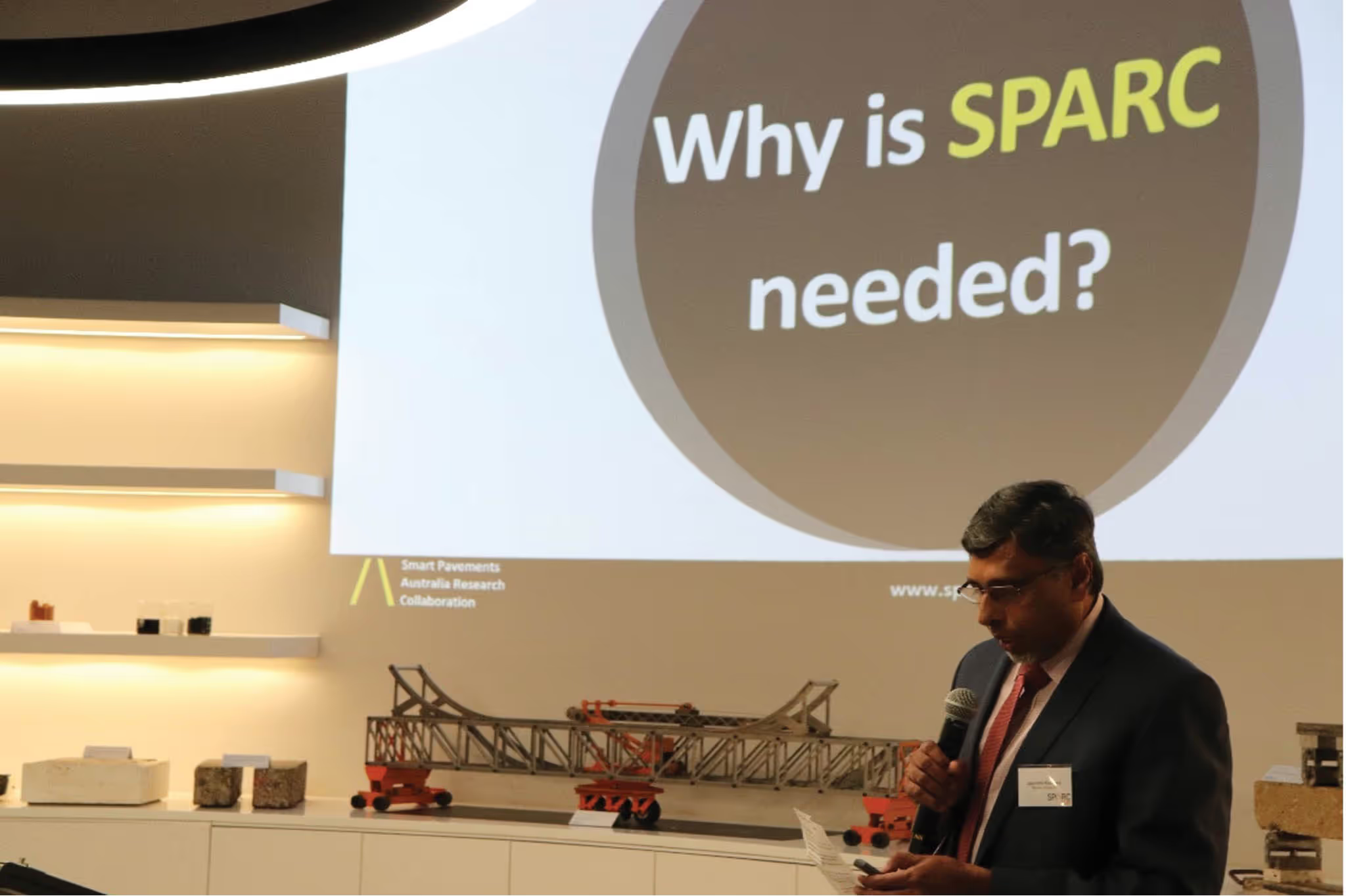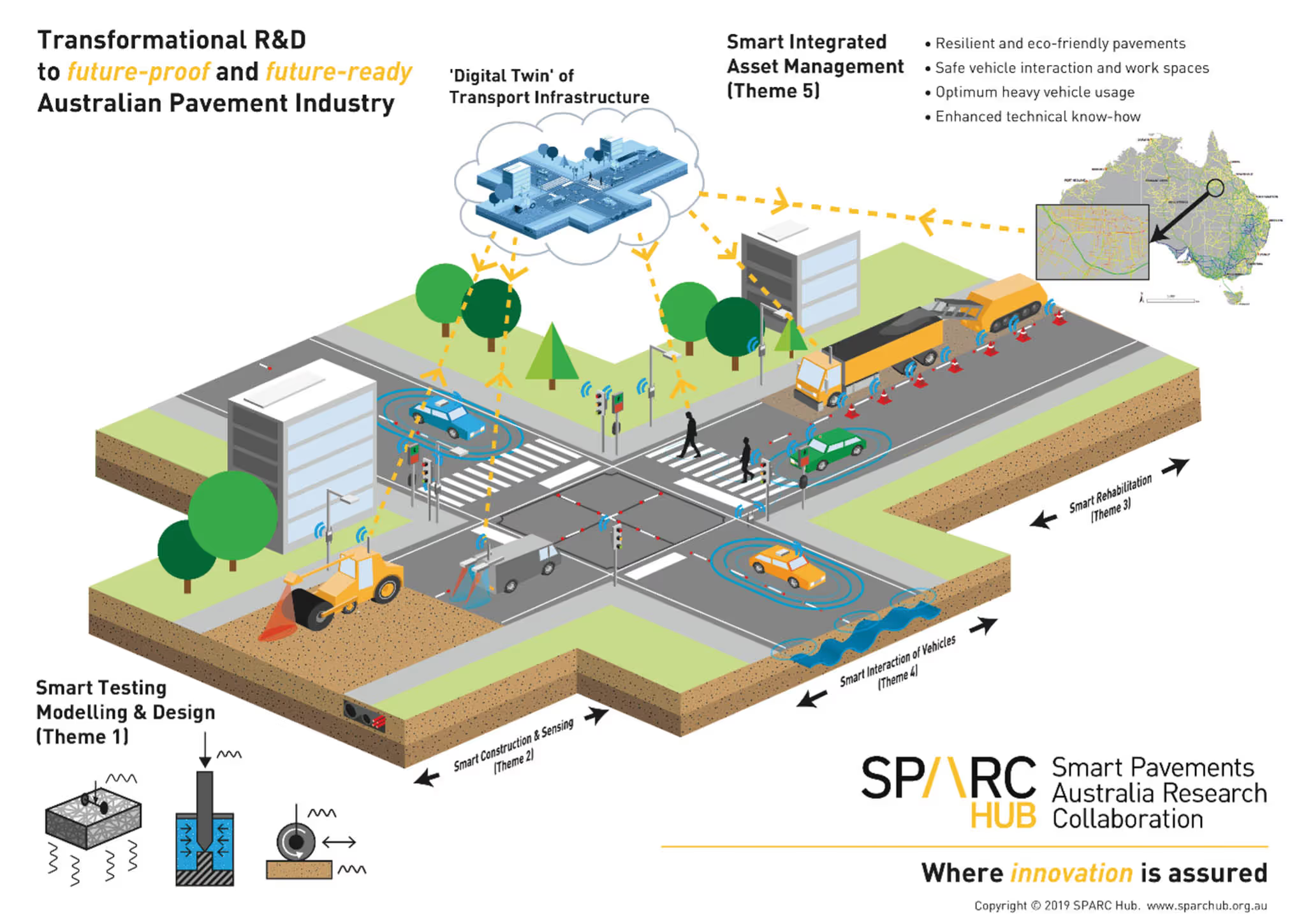

Strong road transport networks underpin the social, economic and cultural fabrics of nations. From Roman roads to Eisenhower’s US Interstate Highway System, nations have flourished with well-developed transport networks. Roads are Australia’s largest publicly owned infrastructure asset, with a replacement value of $200-¬300 billion. Australia spends approximately $30.25 billion annually on roads (BITRE 2019), with up to $7 billion a year spent on maintaining its 900,000 km road network, the world’s highest per-capita maintenance expenditure thanks to our large land mass and relatively small population. Australia therefore needs to be ingenious in constructing, operating and maintaining its roads. This is apparent in its road network, with over 90% of it constructed from relatively low-cost unbound materials with thin seals suited to local climates. Nonetheless, we face a regime of increased road deterioration with increased traffic loads and volumes exacerbated by declining maintenance budgets.
Furthermore, we are facing material scarcity, climate change pressures, the need to reduce our environmental footprint, and the rapid digital transformation of the physical world and vehicle automation. These challenges call for unprecedented, focussed innovation and skill enhancement in the Australian transport pavements sector, and the SPARC Hub provides a university-led collaborative platform to achieve this.
I felt that the Industrial Transformation Research Hub (ITRH) Scheme of the Australian Research Council (ARC) would be a fitting vehicle to establish such an innovation think-tank. After discussions with ARRB, Austroads, AfPA (previously AAPA), Department of Transport (previously VicRoads), QDTMR and construction companies led by CIMIC Group/EIC Activities, we applied for a Linkage grant from the ARC ITRH scheme in 2018. After winning it, we established the SPARC Hub in July 2019, whose hallmark is its stakeholders’ collaborative spirit as encapsulated in our name SPARC – Smart Pavements Australia Research Collaboration (see Figure 1). An intuitive name – we thought – for a Hub aspiring to innovate.

SPARC (www.sparchub.org.au) operates from within the Department of Civil Engineering of Monash University. Our goals are embedded in:
SPARC has a well-developed governance structure, with an executive committee assisted by the Industry Advisory Board (IAB), comprising industry partner representatives and an independent Scientific Advisory Board (SAB).

The SPARC research program runs across five themes led by five leaders, supported by 26 academics from eight Australian universities, with a further 20 industry and seven overseas collaborators. Overall, there are 42 projects undertaken by 37 PhD scholars and six Research Fellows, mostly with doctoral qualifications. Innovatively, a number of experienced and early career ARRB researchers have been seconded to work with the PhD scholars. This provides an unprecedented, vibrant culture of innovation and practical R&D work. Details of some current research projects are included in the current volume of this journal. The overall program is shown in Figure 3.

This theme targets the development of innovative materials for long-life pavements with reduced maintenance costs and enhanced resilience against repetitive traffic and environmental loads. It will make advancements in unbound pavement systems, including more rational laboratory testing methods that lead to more advanced design methodologies and remaining-life estimations. For example:
The influence of climate is not directly considered in Australian unbound pavement design. SPARC research will advance this issue, potentially developing a practical approach incorporating climate in pavement design.
This theme works on smart pavement construction techniques and condition assessment methods when the pavement is in operation. Intelligent compaction (IC) is a recent, evolving technology that uses vibratory rollers equipped with sensors, such as accelerometers. While not widely used in Australia, it is widespread in the USA and Europe. This theme will:
In partnership with industry, novel sensors such as graphene-embedded geotextiles will make future generations of pavements smart and usable for condition assessment through ‘crowd sourcing’, such as using private vehicles to undertake condition assessment.
This theme will develop the use of unutilised fly ash to make geopolymer concrete suitable for pavement construction with a much-reduced environmental footprint. It will also:
Pavements fail at ‘hot spots’ where either compaction is not adequate and/or material is weakened due to excessive localised settlement. The innovation of this technology will also lead to long-lasting pavements, producing economic and environmental benefits and providing infrastructure resilience.
Connected and autonomous vehicles (CAVs) will completely change our mobility patterns and transportation network. This theme researches how smart, next-generation pavements and infrastructure can safely operate and manage CAVs. We will:
Together with Theme 2, multiple smart sensing technologies both in pavement and above the ground, such as mobile GPS, drone and camera-based computer vision, will be fused and assessed for accuracy, reliability, scalability and cost-effectiveness.
This theme will integrate the outcomes of themes 1-4 to develop a smart, optimised road-asset management platform incorporating big data, sensing technologies, traffic data, community impact and engagement. This will be founded on the cloud-based Central Asset Management System (CAMS) developed by RMIT for optimised management of road pavements, which is being refined to receive input data from inspections, sensors and machine vision. We will:
This sophisticated platform will enable dynamic changes to the degradation models for pavement condition considering the use of new sustainable materials in road pavements and the impact of new design and construction methods in prolonging the life of pavements.
The project expects to deliver the above innovations. SPARC is pursuing the concepts of ASSURED innovation developed by Mashelkar (BITRE 2019), to consider ideas that have ‘legs’ in the practical domain. According to Mashelkar, in evaluating an innovation idea, one needs to consider that it will lead to outcomes embedding these features: A – affordable; S – scalable; S – sustainable; U – universal or user-friendly; R – rapid; E – excellent; D – distinctive.
Already a patent has been filed for proximal measurement of pavement material density in real-time during compaction and several other ground-breaking innovations are underway.
With $20 billion spent annually on road construction and maintenance, even an efficiency of dividend of 1% achieved through more durable pavements and reduced maintenance costs may be estimated as $200 million per annum. Since a large portion of citizenry accesses the road network every day, the outcomes would provide significant community benefits daily.
One of SPARC’s key contributions is skills enhancement, making the transport pavements sector competitive locally and globally. The Hub is expected to graduate 37 PhD graduates proficient in a wide range of aspects within the pavement sector. To make these PhD graduates conversant and effective in practice, SPARC has adopted several special measures. These include:
While SPARC has developed an unprecedented collaborative research platform, the constraints of COVID-19 means that 12 of our second cohort of PhD scholars are still to start their projects due to visa and travel delays. Another major difficulty was undertaking fieldwork and some laboratory work.
Another issue is the tight funding base that SPARC has to operate within, especially in relation to our research agenda and fieldwork. In this regard, we invite our current partners to consider additional funded research work or new partners to propose funded research in future.